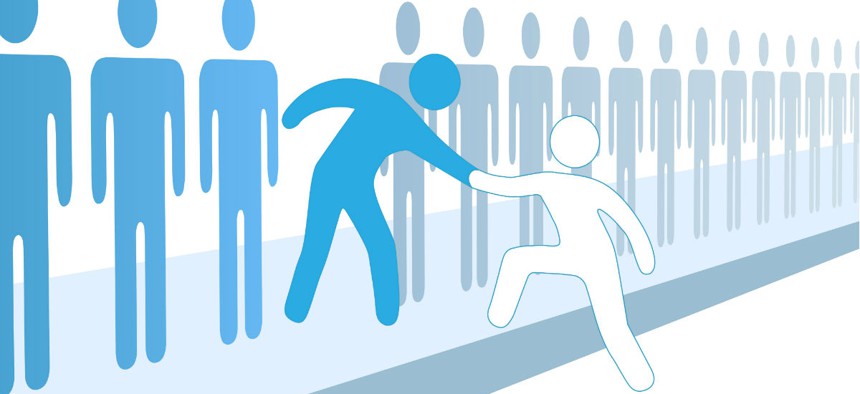
Michael D Brown/Shutterstock.com
This article is the second in a series that examines case studies and model architecture for GaaP (government-as-a-platform).
Technology, connectivity and applications that are noninvasive to existing systems, yet are able to share data and build citizen engagement, offer new ways of delivering government services. The concept, called joined-up government, originated with the Tony Blair administration in the U.K. in the 1990s and has remained an important part of public sector reform.
Joined-up government is based on the view that public policy goals cannot be met through the separate activities of existing organizations, nor can they be delivered by grouping several departments under a common agency. The idea is to align agency activities with particular goals, coordinating activities across organizational boundaries without removing the boundaries themselves. These boundaries may cross between departments, sectors, or government and citizens. To join up, initiatives must align organizations with different cultures, incentives, management systems and aims, and they must align governments to citizens and their needs. The keys are sharing and coordination of information across boundaries to integrate policies and activities.
All governments attempt to join up to some extent or another. Just as the functional separation of agencies is necessary to manage organizational complexity and build expertise, so too is the development of strategies to deal with fragmentation it creates for citizens and businesses. One example is government-as-a-platform, a digital strategy for sharing IT resources across agencies and making public services more accessible. When associated with GaaP, the term “joined-up government” has been linked to innovations such as “no wrong door,” a coordination effort that aims to make the interaction between citizens and businesses more straightforward.
Denmark, for instance, operates a single payment service for businesses, whether it concerns taxes, social service contributions, fees, or licenses. Government invoices – irrespective of which agency they originate in – can be paid through a single electronic channel. New York operates an online permitting and licensing system that guides new businesses through 1,100 potential application forms spread across the city’s departments.
Many of the fragmentation challenges can be solved by building services that are shared across agencies, joined-up government is focused on the collaborative nature of delivering services. One such example is San Diego County’s Knowledge Integration Program, where case workers from different health and human services departments can collaborate to create better outcomes for citizens with chronic diseases such as diabetes or asthma, substance addictions or mental health problems. The information exchange will initially connect thousands of case workers who can share case notes, coordinate referral plans, and collaborate with external service providers such as physicians, clinics, psychologists and physiotherapists.
Another example of interdepartmental collaboration is Rio de Janeiro. City officials built a modern command center that coordinates the activities of more than 30 municipal and state departments plus private utility and transportation companies. The command center allows departments to collaborate on shared goals such as the smooth execution of the FIFA World Cup in 2014 and the Summer Olympics in 2016.
Joined-up government requires collaborative governance, the shared vision, aligned incentives, shared technical systems and data – all of which enable the exchange of information among departments and agencies.
GaaP enables this by providing tools for rationalizing data to establish a single or 360-degree view of constituents and the broader context they find themselves in. This supports collaborative systems as an integrating layer over existing departmental systems and data. It is a noninvasive approach from the outset and one that attempts to build upon what is already in place instead of trying to replace it. In San Diego County, the information exchange sources data from existing case management systems and provides case workers with a new set of features for case note collaboration, integrated referral planning and citizen consent management, none of which previously existed on a cross-departmental level. It also provides a single view of the citizen across government.
GaaP provides a platform not only for consuming data and services from existing applications, but also for building new joined-up services, and it provides a certain degree of openness in terms of who is allowed to build them. At times, it will be left to agencies and departments while in other cases the work may be executed by citizen groups or private sector service providers.
The primary challenges of joined-up government are found in the traditional barriers to cross-organizational collaboration – in which a shared political vision, aligned rewards and incentives and an openness to engage more broadly are prerequisites for success. While a buzz word for a new way of organizing government and its services in the 1990s, joined-up government enabled by GaaP technologies offers new ways to envision service improvements and build collaborative engagement models that work across boundaries.
Peter Williams is chief technology officer for Big Green Innovations at IBM, where Jan Gravesen is client technical leader for California and Trinette Brownhill is information architect for Government Industry.
(Image via Michael D Brown/Shutterstock.com)
NEXT STORY: Play of the Day: More on Donald Trump's Hair






